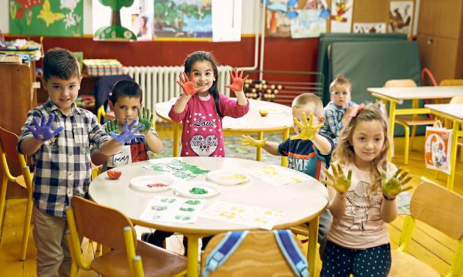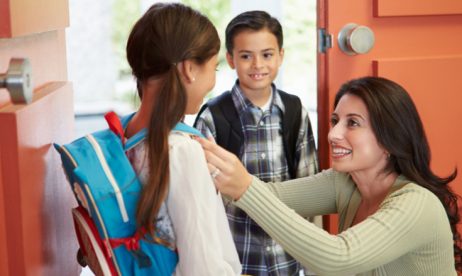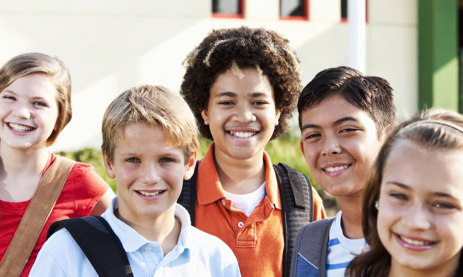Pre Primary Curriculum
Our Philosophy
We envision to spark human greatness in every single child by discovering and then nurturing each child’s unique gift. As pre-primary is a crucial stage in a child’s life, we have very thoughtfully planned the curriculum for our pre-primary students. It allows for a child to develop their curiosity, play, relationships, interests, sense of self and place, creativity, and independence, all of which this curriculum helps to foster.
We firmly opine that it is mandatory for schools to break their monotonous educational regime and embrace an ardent approach to overcome the hurdles that this ever-changing world has to offer. At Mount Dios International School, the process of equipping the child with the necessary tools for growth is shaped by blending the strengths of different curriculums. Our curriculum is thus devised to promote a comprehensive learning environment which will encourage broadening of horizons and manifestation of strengths and capabilities
The curriculum is designed to span two years, ages four to six. The majority of the content is universal across both years for two reasons: developing continuity and cohesion in the practices and principles, and recognizing the wide range of abilities children can have in these two years.
Mount Dios curriculum is divided into age appropriate monthly themes. The integrated and interdisciplinary learning system, along with engaging and hands-on activities, ensures that all our children are successful learners. The methodology ensures that learning is thought-provoking and empowering since it is based on the latest theories, brain research, and best practices in education.
The themes and Lesson Ideas begin with the child’s most immediate knowledge, guiding them towards a stronger conception of themselves before moving outwards to familiar people and environments, the city, other living beings, other parts of the country and world, and other time periods. The curriculum for Nursery progresses through Hello World, Our Home, Creators, and Explorers; Kindergarten takes children on a journey through Living Beings, Citizens of the World, Happy and Healthy, and Time Machine.
The following characteristics are integral throughout the curriculum, including the guides, learning objectives, Lesson Ideas, and resources:
Respect for the individual
Just as the curriculum is a framework to be adapted to individual schools, it is to be adapted to the individual students at every stage. Teachers are continually reminded and encouraged to spend time getting to know each child, understanding their needs and abilities, respecting the variation caused by different learning and social abilities, and adapting the level of work and means of communication to the individual child.


Diversity
The content for lessons, the recommended books, and the guidelines for teachers steer the curriculum towards an ongoing appreciation of diversity in all its forms: knowledge, skills, physical and mental abilities, personalities, family structures, cultures, and backgrounds. Books, toys, and activities are designed to be open to all genders and restrictive to none. The curriculum is founded on a classroom that is welcoming to different physical abilities from the outset, in which all children are not expected to fit a standard for social interactions, and in which childrens’ perceptions of themselves and others are continually expanding.
Family involvement
Families are important to this curriculum: at regular points in the year they are invited to be a part of the class discussions, to contribute through their experiences and knowledge, and to learn with the children. The curriculum is also designed to be adapted in a manner wherein, in consultation with children’s families, it incorporates knowledge and knowledge systems that are relevant and meaningful to the children and their families


Creativity
Children’s creative, constructive abilities are harnessed through the regular inclusion of hands-on work such as cooking, painting, cutting and pasting, fabric and bead work, sculpting, construction, and gardening. Some of these activities are collaborative, for example, learning the effect of specialization and dividing tasks or designing and making something to fit a friend’s needs and preferences, whereas others are individual in nature, supported by the teacher. Here children are encouraged to as questions and their reasoning is developed through their work. This enhances their sense of ownership and their criticality
Questions: Inquiry based learning approach
Children naturally ask questions and this curriculum actively fosters this tendency. Lessons are built around the teacher asking the children some initial and guiding questions and allowing the discussion, research, and activities to be led by the questions children ask. “What if,” “why,” “how,” “could you/we,” “where,” and “when” questions form the base of an exploration of a topic, whether about the child’s own knowledge and experience or about an entirely unknown domain. Instead of solely providing information directly, the Lesson Ideas encourage teachers to prompt the children with questions, to discuss what they think as a class and then to use books and websites to find answers
and develop the child’s research skills.


Rootedness: Cultural Equilibrium
Indian and global are not seen as mutually exclusive or competing in this curriculum; the books, activities, Lesson Ideas, and curriculum themes root the children’s learning in their local context while opening their awareness of and curiosity about new places and people. Children study and make indigenous art, Indian music, regional food and dress, interact with their local community, discuss their languages and traditions, and are shown that India is an exciting, diverse place with people, cultures, and natural environments that should be respected and looked after.
Relationships: Motor skills, Social skills
This curriculum explicitly educates children with a sense of responsibility to others and an appreciation of what others do for them, including their family, their classmates, the wider school community, and others in the city. Furthermore, peaceful conflict resolution, democratic/class-led rule-setting, discussing feelings and interactions, and inculcating inclusion are all integral parts of the curriculum. This curriculum opens a myriad of opportunities for exploration, growth, sharing, relationship building, and skill development in both the children and the teachers.
